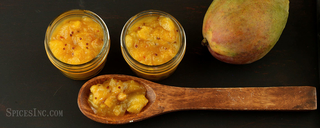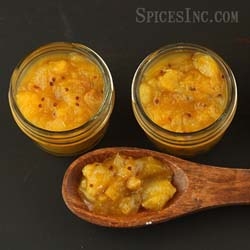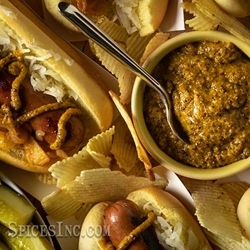Black Mustard Seed
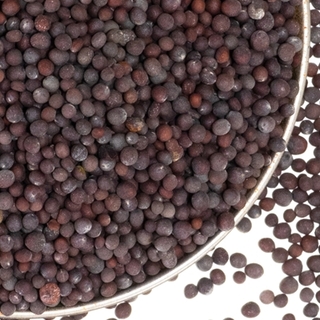
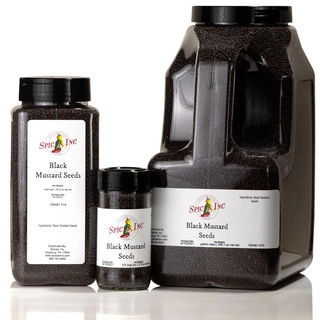


Black Mustard Seed
Black Mustard Seeds
Black Mustard Seeds, Brassica nigra, are also called black mustard, brown mustard, or true mustard. There are more than 40 varieties of mustard plants, but culinary mustard seeds come from only three of these varieties.
Black Mustard Seeds have a volatile oil concentration of between 0.5% to 1.2%.
What Are Black Mustard Seeds
There are three main types of mustard seed. Black Mustard Seeds are used less frequently than brown or yellow mustard seeds and are much harder to find. The smaller and darker the seed, the hotter and more intense the flavor is. Black mustard is the smallest of the mustard seeds and is oblong in shape. While mustard seeds are frequently used in preparing condiments, black mustard is rarely used in this manner due to its pungency being very volatile.
Black mustard seeds have a well deserved reputation for their pungent spicy aroma and flavor. Most common in Indian cooking black mustard seeds are often fried in oil, making them sweet and mild while releasing a nutty aroma. This is frequently done in an Indian wok called a kadai.
Types of Mustard Seeds
Mustard seeds are the small round seeds that come from several different types of mustard plants. The seeds are approximately 1-2 mm in diameter. The seeds (also called fruit pods) come from the mustard plant in the Brassica family. Some of the other members in this family include broccoli, Brussels sprouts and cabbage. Mustard seeds are harvested from three different plants: white mustard (better known in this country as yellow mustard from Brassica alba), brown mustard (Brassica juncea) and the very hard to find black mustard (Brassica nigra).
White (or yellow) mustard seeds have the mildest taste of the 3 and are we know them in this country for our ballpark style yellow mustard. Yellow Mustard Seed are also the largest in size of the three. Brown Mustard Seed have an acrid pungency that is long lasting and this is the mustard seed used to make Dijon mustard.
Black Mustard Seeds are the most intense of the mustard seeds and are super hard to come by as they cannot be harvested like other mustard seeds. They are the only type that must be handpicked, so machine harvesting must be replaced by labor intensive man power. Black mustard seeds are popular in Indian cooking and are typically fried in oil to make them sweeter and nuttier. Be wary of suppliers trying to pass off brown mustard seeds as black.
What does Black Mustard Seed Taste Like
Very intense pungency that begins slowly at the back of the mouth which is then followed by a shooting sensation to the sinuses.
This sensation is similar to two other spices from the same family – Pure Wasabi Powder and Horseradish Powder.
What is Black Mustard Seed Good For
Black Mustard Seeds are used with Brown Mustard seeds in Dijon mustards. Also used in the German Düsseldorf mustard which is similar to the French Dijon Mustard, but tends to be more pungent. In southern India vegetarian dishes, Black Mustard Seeds are “popped” in heated oil or ghee which enhances their nuttiness, and then added to chutneys, curries, dals, pickles, sambars, and sauces.
Black Mustard Seed oil is used in Bengali, Kashmiri, northern India and Pakistani dishes. We like to use them in curries, lentil soups, roasted vegetables and sautéed potato dishes.
What can be Used Instead of Black Mustard Seeds
Mustard seeds can be substituted for one another, so you can use the Brown Mustard Seeds in place of the black quite easily at a 1:1 ratio. You can also use Yellow Mustard Seeds just keep in mind that the lighter the mustard seed, the less pungency it will have, so be sure to taste as you are seasoning.
History of Black Mustard Seeds
The origin of Black Mustard Seed is unknown but it is probably indigenous to the Southern Mediterranean region and has been both grown wild and cultivated for thousands of years; therefore, numerous cultivars are found1. At present it grows wild in the Mediterranean region, throughout central Europe, in the Middle East and in the Ethiopian highlands. Black mustard was likely the first mustard species harvested as a spice as it grew in the wild or was cultivated with cereal crops. Its use predates recorded history with seeds, ready for sowing, found in a Bronze Age (3300 BC - 1200 BC) lake dwelling at the Bielersee (Lake of Bienne) in Switzerland and in vessels in northwest China dating to 5000–4000 BC2. Sanskrit text references mustard as early as 3000 BC. Sanskrit writers distinguished between white and brown mustard3. Black Mustard is thought to be the mustard seed referred to by Jesus in the Parable of the Mustard Seed4. Black Mustard was a late import into India. There is little to no written record or archeological evidence as to when Black Mustard was first used or started gaining wider acceptance.
Black Mustard has been naturalized in Central Europe since Roman times (27 BC - 476 AD) and in the sixteenth century began thriving in river valleys. Since the 1950s, black mustard has become less popular as compared to Indian Brown Mustard Seeds as they can be mechanically harvested in a more efficient manner.
Black Mustard Seed Cultivation
An easily grown plant, Back Mustard is suited to many types of soils but grows best in light sandy loams, or deep rich fertile soils. It can be grown in temperate zones but is equally suited to tropical areas. The plant tolerates an annual precipitation of 12 to 65 inches with annual average temperature range of 45 to 80°F5.
Early growth of the Black Mustard plant is very rapid and the plant will typically reach two to eight feet in height while being sparsely branched. The plant may start flowering in as little as 2 weeks after germination, but this usually does not occur until after 4-6 weeks6. The plant produces small yellow flowers that are typically up to 1/3 inch across, with four petals each. The leaves are covered in small hairs and can wilt on hot days but tend to recover at night.
The plant produces many short fruits. The fruit is a smooth pod, about 1/2 inch long with a short beak at the tip. Pods are erect, holding close to the stem. Each pod holds an average of four seeds which can be a very dark brown to black with a rough textured surface7. Fruit ripening starts at the base of the plants and proceeds upwards. The crop is ready for harvesting 40-100 days after sowing. To avoid shattering, pods are harvested when still closed but mature, preferably early in the day. Sometimes plants are cut and dried on the threshing floor prior to threshing by beating with wooden sticks8. Unlike white and brown mustard seeds, which can be machine harvested, black mustard seeds can only be harvested by hand.
Where is Our Black Mustards Seed From?
India.
| Ingredients | Black Mustard Seeds |
| Also Called | Black mustard, brown mustard, or true mustard |
| Recommended Uses | Use in Dijon mustards, whole seed deli mustard, curries, lentil soups, roasted vegetables, and potato dishes |
| Flavor Profile | Pungent and spicy with some heat |
| Oil Content | 0.5% to 1.2% |
| Botanical Name | Brassica nigra |
| Cuisine | Indian, Mediterranean |
| How To Store | Airtight container in a cool, dark place |
| Shelf Life | 1-2 years |
| Country of Origin | India |
| Dietary Preferences | Gluten Free, Kosher, Non-GMO |
| Allergen | Mustard |
Hungry for More Information
Spice Cabinet 101: Mustard
What Spices Go with What Meat
Flavor Characteristics of Spices
Volatile Oils of Spices
References
1 Katzer, G. (2013, May). Spice Pages: Black Mustard Seeds (Brassica nigra/juncea). Gernot Katzer’s Spice Pages. Retrieved December 12, 2021.
2 Mustard | Encyclopedia.com. (2018, June). Encylopedia.Com. Retrieved December 13, 2021.
3 Mehra, K. L. (1968). History and ethnobotany of mustard in India. Advanced Frontiers Plant Science. Published.
4 Marshall, H. I. (1978). The Gospel of Luke : a commentary on the Greek text. Paternoster Press.
5 Koch, W. D. J. (2010). Brassica nigra Black Mustard PFAF Plant Database. Plants For A Future. Retrieved January 2, 2022.
6 Brassica nigra (black mustard). (2019, November 21). CABI. Retrieved January 2, 2022.
7 Brassica nigra (Black Mustard): Minnesota Wildflowers. (2006). Minnesota Wildflowers. Retrieved January 2, 2022.
8 Duke, J. A. (1997, December 30). Brassica nigra. Purdue University Horticulture and Landscape Architecture. Retrieved January 2, 2022.
Nutrition Facts
Serving Size1 tsp
Amount Per Serving
Calories16
% Daily Value*
Total Fat1g1%
Saturated Fat0g0%
Trans Fat0g
Polyunsaturated Fat0g
Monounsaturated Fat0g
Cholesterol0mg2%
Sodium0.3mg0%
Total Carbohydrate1.0g0%
Dietary Fiber0.8g3%
Total Sugars0.2g
Added Sugars0g0%
Sugar Alcohol0.0g
Protein1.0g1%
Vitamin D0mcg0%
Calcium13mg1%
Iron0mg2%
Potassium26mg1%
*The % Daily Value (DV) tells you how much a nutrient in a serving of food contributes to a daily diet. 2,000 calories a day is used for general nutrition advice. These values were calculated and therefore are approximate. For more accuracy, testing is advised.

